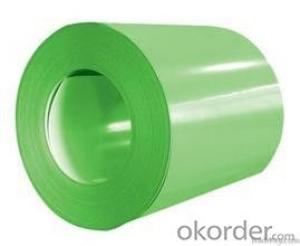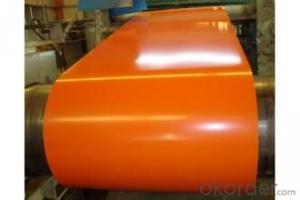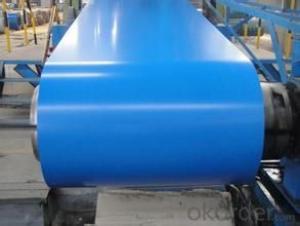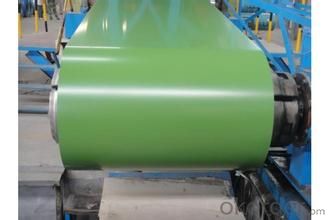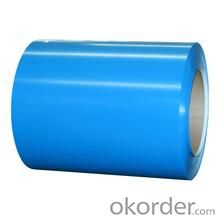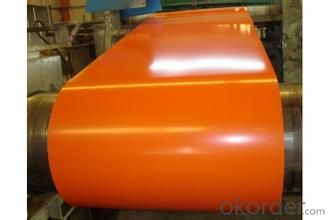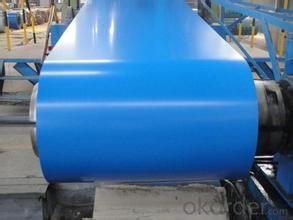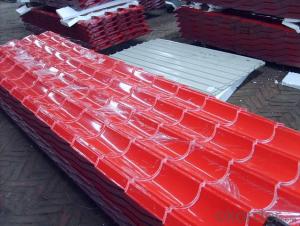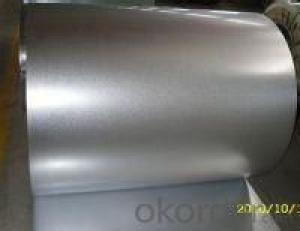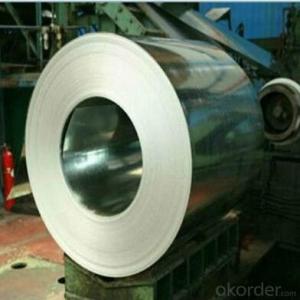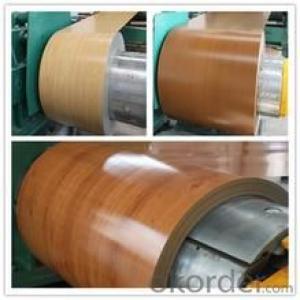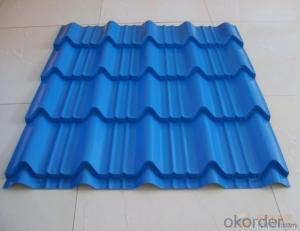Prepainted Galvanized Rolled Steel Coil-DX51D in China
- Loading Port:
- Tianjin
- Payment Terms:
- TT OR LC
- Min Order Qty:
- 30 m.t.
- Supply Capability:
- 500000 m.t./month
OKorder Service Pledge
OKorder Financial Service
You Might Also Like
Brief Introduction
Prepainted Galvanized Steel usually refers to have substrateprocessed with surface processed and coated then(roller coated )or bonded organic thin film and baked, and it is able to be processed tofinal prodevtion .
PrepaintedGalvanized Steel qualified with excellent decorative ,formability ,corrosionresistance ,coating adhesion ,can keep for a long time as well as maintainfresh color .For color coated steel sheet can obtain good economicbenefit by steel belt wood ,efficient in construction and save energy ,preventpollution etc.Which is an ideal material;for manufacturing board.
Sample Charge
1.Samples charge:According to your requirements . Sampling time:30days with minimum qty order.
2.Samples charge:Free for Existing Samples Sampling time:1day
Advantage
1. Low MOQ: We will do our best to make you satisfied.
2.Good Service : We treat clients as friend.
3.Good Quality :We have strict quality control system .Good reputation in the market.
4.Fast & Cheap Delivery: We have big discount from forwarder (Long Contract).
5.Supply Ability: 50000 ton monthly
Technical Data Of Prepainted Galvanized Steel
Yield Strength | (Mpa) 280-320 |
Tensile Strength | (Mpa) 340-390 |
Elongation | 20%-30% |
Reverse Impact | 9J |
T-bending | ≥2T |
Pencil Hardness | ≥2H |
Duration Of Salt Spray Test | 500 H |
Bending At 180 Degree | No crack, purling and fraction |
Applications OfPrepainted Galvanized Steel
It can be widely used in transportation, light industry, civil usage and farming. It is also the perfect building material in construction for making steel roofing,insulation panel, corrugate sheet, facade wall,shutters,T-bar and home appliance.
- Q: What are the different methods of transporting steel coils?
- There are several methods of transporting steel coils, including using flatbed trucks, railcars, and ocean vessels. Flatbed trucks are commonly used for short distances and local deliveries, while railcars are utilized for longer distances and intermodal transportation. For international shipments, steel coils are typically transported on ocean vessels, either in containers or as breakbulk cargo. The choice of method depends on factors such as distance, destination, and cost-effectiveness.
- Q: If rail ties were melted, would they be like any other type of steel?
- As so much about the railroad is variable, so is the steel used for the rail. For one thing, all rail is not the same size. It is classified by weight per yard. For example, most tangent (straight) track is 139 lbs rail, meaning three feet of it weighs this much. Secondary track, such as found on branch lines and in yards or used on sidings is not as heavy. Track used in curvature may be the same weight, but not always. The reason is there is much more stress imparted to the roadbed in curvature. Most steel on main tracks has a higher carbon content, but there is a point of diminishing returns, as this rail is more brittle as a result. Good luck trying to melt it. In the field, this rail is cut by a saw with diamond studded circular blades. The reason why is it takes a lot more time to try to cut it with an acetylene torch. In the US, certain areas, such as on some bridges, the cross-ties (sleepers) are indeed made of steel, in addition to concrete and wood. The potential for fire is too great for wood in these instances. In addition, if even a single wheel derails, concrete ties tend to explode when stressed this way. All of which makes steel cross-ties worth the extra cost.
- Q: how is stainless steel made? what are the things used in making it?
- There are 3 basic stainless steels. The Martinsitic, the ferritic, and the Austinistic. The spelling may be wrong on all of them. (Got out of school in 1966 with my metallurgy in 1965. The Ferritic is magnetic and has some resistance to corrosion but the Martinsitic is much more resistant to corrosion. The Austinitic stainless is very resistant to corrosion. The differences are the amount of Chrome and Nickel in the batches. The Austinitic has an 18/8 ratio of Chromium and Nickel with the rest Iron and minor ingredients. The carbon content is very important and these steels are often made in small batches with close monitoring of composition and carbon content. Scrap metals are frequently used with the chrome and nickel being added as carefully selected scrap or even fresh crude stocks. Electric melting is frequent to avoid contamination.
- Q: Steel roofing info. Pros and cons on steel roofing?
- Steel roofing Pro...life of product is much longer then Asphalt shingles....Looks great...multi colors.......Just love the stuff... Cons....More costly then singles at first but since it last longer it is really a better buy.......
- Q: Can steel coils be coated with epoxy?
- Yes, steel coils can be coated with epoxy. Epoxy coatings are commonly used to protect steel from corrosion and provide a durable finish.
- Q: Can steel coils be coated with anti-graffiti materials?
- Yes, steel coils can be coated with anti-graffiti materials.
- Q: What are the different methods of edge wave correction for steel coils?
- Steel coils often experience edge waves, which are deformations along the edges. To address this issue, various methods are commonly employed. One frequently used technique is edge wave flattening. This involves applying pressure to the coil's edges using hydraulic or mechanical devices. By doing so, any waves or deformations are effectively flattened out. Edge wave flattening can be performed during the coil processing stage or as a separate step after production. Another approach is edge trimming, where the coil's edges are trimmed or cut to remove waves or deformations. Mechanical shearing or laser cutting technology can be utilized for this purpose. Edge trimming not only corrects edge waves but also ensures straight and smooth edges. Tension leveling is another popular method. It involves subjecting the coil to tension forces, which stretch and flatten any waves or deformations. Tension leveling is typically performed during the processing stage and is effective in correcting both edge waves and other surface defects. Roll leveling is also effective for correcting edge waves. This method utilizes a set of rolls to gradually apply pressure to the coil, resulting in the flattening of waves or deformations. Roll leveling is a versatile technique that can address various types of coil defects, including edge waves. Furthermore, advancements in technology have led to the development of automated edge wave correction systems. These systems employ sensors and computer algorithms to detect and correct edge waves in real-time during the coil processing stage. This method ensures precise and consistent correction, reducing the need for manual intervention and improving overall efficiency. In summary, the methods for correcting edge waves in steel coils include edge wave flattening, edge trimming, tension leveling, roll leveling, and automated correction systems. Each method offers unique advantages and can be chosen based on the specific requirements and constraints of the coil processing operation.
- Q: What are the different cutting methods for steel coils?
- Steel coils can be cut using various methods depending on specific requirements and desired outcomes. Some commonly used cutting methods for steel coils include: 1. Slitting: Narrower strips can be obtained by cutting the steel coil using a slitting machine equipped with multiple circular blades. The coil is unwound and passed through the blades, resulting in the desired width. Slitting is commonly employed in industries like automotive manufacturing or electrical appliance production, where narrower steel strips are needed. 2. Shearing: This method involves using a shear machine with a straight blade to cut through the steel coil. The blade presses against the coil, cutting it into desired lengths or shapes. Shearing is ideal for applications requiring precise cuts or specific sizes. 3. Laser cutting: A high-powered laser is used to cut through the steel coil in this advanced method. The laser beam is directed onto the coil, melting or vaporizing the metal to create a clean and accurate cut. Laser cutting is highly precise and can be used to cut intricate designs or patterns into the steel coil. It finds applications in industries such as aerospace, automotive, and electronics. 4. Plasma cutting: A high-velocity jet of ionized gas, usually a mixture of oxygen and an inert gas like nitrogen or argon, is employed to melt and remove metal from the steel coil. Plasma cutting is known for its speed and versatility, as it can cut through various metals, including steel. It is commonly used in industries like shipbuilding or construction, where fast and efficient cutting is required. These are just a few of the cutting methods available for steel coils. The choice of method depends on factors such as desired outcome, coil thickness, and specific application requirements. It is advisable to consult with a professional or specialist to determine the most suitable cutting method for your specific needs.
- Q: What really is the difference between stain-less steel and iron? I only know that iron is an element, and stain-less steel is an alloy...but what else is there?
- alloy is a mixture of multiple metals or some other elements. like some steel is mixed with carbon and iron so that alloy is more hard than the pure iron. some of them is mixed with aluminium and iron. that's all depends on the requirement.
- Q: Can one assume that stainless steel that can be hardened is magnetic?
- actually stain less steel is mainlly three first one is austenitic, 2nd one is ferritic, and 3rd is martensitic. These three types of steels are identified by their microstructure or predominant crystal phase. Austenitic. Austenitic steels have austenite as their primary phase (face centered cubic crystal). These are alloys containing chromium and nickel (sometimes manganese and nitrogen), structured around the Type 302 composition of iron, 18% chromium, and 8% nickel. Austenitic steels are not magnetic and not hardenable by heat treatment. The most familiar stainless steel is 304 containing 18-20% chromium and 8-10% nickel. Ferritic. Ferritic steels have ferrite (body centered cubic crystal) as their main phase. These steels contain iron and chromium. Ferritic steel is somewhat magnetic, less ductile than austenitic steel, and is not hardenable by heat treatment. Martensitic. Martensitic steels have orthorhombic martensite as their main phase. Martensitic steels are low carbon steels. They are magnetic, and may be tempered and hardened. Martensite gives steel great hardness, but it also reduces its toughness and makes it brittle. If you ran around the house with a magnet, checking on the items you know are stainless steel, you would probably find that cookware and flatware are not magnetic, but cutlery might be slightly magnetic.
Send your message to us
Prepainted Galvanized Rolled Steel Coil-DX51D in China
- Loading Port:
- Tianjin
- Payment Terms:
- TT OR LC
- Min Order Qty:
- 30 m.t.
- Supply Capability:
- 500000 m.t./month
OKorder Service Pledge
OKorder Financial Service
Similar products
Hot products
Hot Searches
Related keywords

